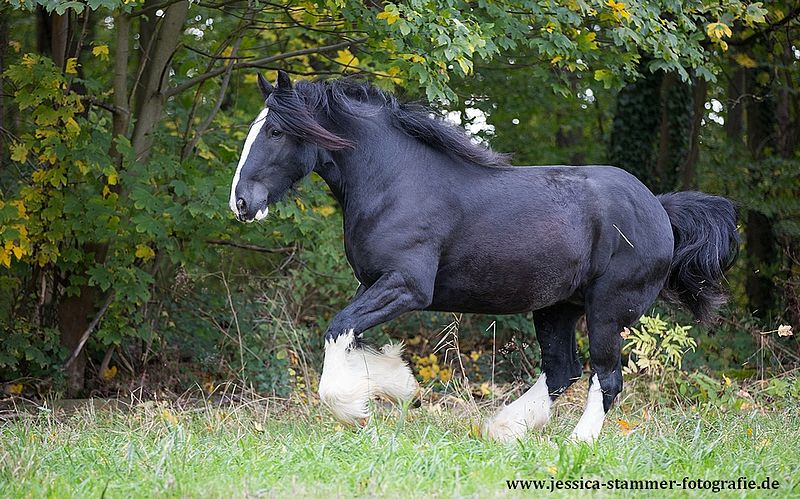The Shire Horse
The British Sbire or Shire Horse (“county horse”) is the oldest of the heavy draft horses. Caesar already reported the presence of a large black horse (Equus magnus) in northern England. In the Middle Ages, infusions of Flemish blood gave it more strength, bravery, and agility. It took the name of Great Horse or English Great Horse, of heavy Cob type, massive, with a heavy head and smaller (1,60 m) than the current Sbire. It became a war horse.

In the 16th century, to preserve the large size of horses, King Henry VIII prohibited the breeding of small English horses. In the XVth century, Dutch horses (Black Friesian) and horses from Flanders were imported to clear and drain the marshy region of the Fens, in the east of England. The Great Horse takes the name of “English Black Carthose” or “Old English Black Carthose”, the largest and most powerful carriage maker in the world. A Studbook is created in 1878. In 1884, foundation of the Shire Horse Society which gives the name of Sbire in reference to the counties of the center of England which were the cradles of the race. It is believed that the Packington Blind Horse stallion, born in 1755, was the founder of the breed.
At the end of the 19th century and the beginning of the 20th century, there were massive exports to the United States, Russia, and Australia. Between 1950 and 1965, the breed was threatened with extinction. Currently, the numbers are increasing. In 1995, the Shire Horse France was born, following the introduction of this breed in the 1980s.
Caractère et aptitudes du cheval
Calm, patient, docile, this horse is very powerful, resistant, enduring, and courageous. Its gaits are lively and easy. It has a long stride, a very high trot, and a quiet canter. He is an adult at 7 years old.
Utilisations du cheval
Remarkable horse of harnessing: agricultural work, hauling of boats, skidding in forest, urban traction (advertising teams of brewers for example). Crossed with a saddle horse, it gives a hunting horse, Hunter type. It is also appreciated as a saddle horse.
Morphologie du cheval
Herculean horse, majestic, endowed with a powerful musculature and remarkable by its nobility of gait. Size: from 1,60 to 1,90 m. The largest horse in the world with a stature record of 2.19 m held by Sanson, a stallion born in 1846. Weight: from 700 to 1 200 kg. Head carried straight, long, thin, dry. Wide forehead. Profile slightly convex. Pronounced jaws. Thin lips sometimes with moustache. Wide open nostrils. Ears long, thin, fine, and pointed. Large, prominent eyes. Ample body, rounded, of brevilinear type. Strong neck, long, a little arched. Withers broad, outstretched. Broad chest. Deep chest. Rounded ribs. Long, muscular, and sloping shoulders. Short, strong, broad back. Hindquarters long, powerful, well muscled, rounded. Round and sloping croup. Limbs long, very strong, very bony. Wide joints. The circumference of the barrel can reach 28 to 30 cm. Furnished, stiff dewlap. Wide, strong, solid, thick-walled feet. Tail set high, carried straight. Coat: black, bay, brown bay, grey. Distinctive markings: barnacles, lead list.


